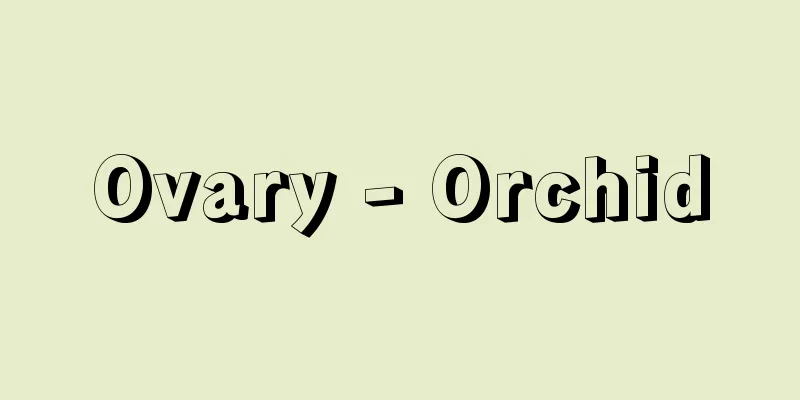Ovary - Orchid

|
The gonads are found in female vertebrates and invertebrates, and are responsible for the formation and release of eggs that are involved in fertilization. In mammals, both ovaries develop, but in birds, the right ovary is degenerate, and only the left develops significantly. In general, many animals have degenerate ovaries, which produce eggs with a lot of yolk. In mammals, the end of the uterus is a coiled or trumpet-shaped oviduct, and some oviducts are always in contact with the ovary, while others are only in contact during ovulation, and fertilization often occurs here. Mammalian ovaries are made up of follicles, which mature eggs, corpora lutea, which are follicles that become luteinized after ovulation, and stroma. Follicles and interstitial cells secrete female hormones, and the corpus luteum secretes hormones necessary for the implantation of fertilized eggs and the maintenance of pregnancy. Many animals secrete male hormones from the stroma. Invertebrates do not necessarily have only one pair of ovaries; some have multiple ovaries in each segment, and some have ovaries in radial symmetry. The ovaries form from the genital ridges of the coelomic epithelium, while the eggs migrate from the yolk sac. [Takasugi Akira] Ovaries in humansThe human ovaries are female reproductive organs, equivalent to the male testes. They are located on both sides of the uterus, slightly below the pelvic division line, which is the boundary between the greater and lesser pelvis. The ovaries are flattened ellipses and fairly hard solid organs. Macroscopically, they are grayish-white with a reddish tinge. In Japanese people, the size is 2.5-3.5 cm in length, 1.2-1.9 cm in width, 0.6-1.1 cm in thickness, and 4-10 grams in weight, but there are various differences depending on age, functional status, individual differences, etc. The surface of the ovaries is smooth before sexual maturity, but when large follicles begin to develop, the surface of the ovaries begins to swell, and scarring is formed by ovulation, making them uneven. However, when ovulation ceases, the ovaries enter a state of atrophy. Within the pelvis, the ovaries are oriented with their long axes almost vertical, but in parous women, their long axes become closer to horizontal. The ovary has two sides, an inner and an outer. The inner side faces the pelvic cavity and is mostly in contact with the fallopian tube. The outer side faces the pelvic wall. The posterior edge is called the free edge, which is bluntly rounded and strongly raised, facing posteriorly and medially, while the anterior edge is called the mesenteric edge, which is nearly straight and faces anteriorly and laterally. The mesenteric edge is the beginning of the mesovarium. The mesenteric edge has a groove through which blood vessels and nerves enter and exit, and is called the ovarian hilus. The upper end of the ovary is called the ovarian end, and has a blunt edge, but faces the infundibulum and reaches the fimbria of the fallopian tube. The lower end of the ovary is called the uterine end, and is sharply protruding and connected to the uterus by the proper ovarian cord, which is made of connective tissue containing smooth muscle. The position of the ovary is fixed by this proper ovarian cord and the ovarian ridge that stretches from the end of the fallopian tube to the side wall of the pelvis. The inside of the ovary is divided into the cortex on the outside and the medulla in the center, but the medulla is filled with fibrous connective tissue called the ovarian stroma. The cortex contains follicles in various stages of development, but when antral follicles (containing mature egg cells with a diameter of 200 micrometers) approaching ovulation grow significantly, they occupy the entire cortex and protrude from the ovarian surface. Follicles just before ovulation are called mature follicles (Grafian follicles). After ovulation, blood flows into the large cavity from the surrounding blood vessels, filling the inside, but is soon absorbed and the connective tissue corpus luteum is formed. The corpus luteum contains luteal cells, which secrete the luteal hormone (progesterone). If the egg is not fertilized, it atrophies after 2 to 3 weeks and disappears after 6 to 7 weeks (this is called the menstrual corpus luteum). The scar tissue that appears after the disappearance of the corpus luteum is called the corpus albuginea. When the egg is fertilized, the corpus luteum develops and enlarges, and persists until birth (called the corpus luteum of pregnancy). The medulla in the center of the ovary is a soft tissue that is rich in blood vessels, lymphatic vessels, and nerves. Even in newborn girls, about 400,000 primordial follicles are found in the ovarian tissue of both sides, but it is thought that only about 400 of these follicles will reach ovulation between sexual maturity and the end of menstruation. [Kazuyo Shimai] [Reference item] | |©Shogakukan "> Location and structure of the ovaries Source: Shogakukan Encyclopedia Nipponica About Encyclopedia Nipponica Information | Legend |
|
脊椎(せきつい)動物と無脊椎動物の雌性個体に存在し、受精に関与する卵を形成し放出する生殖腺(せん)をいう。哺乳(ほにゅう)類では左右の卵巣とも発達するが、鳥類では右側の卵巣が退化的で、左側だけが著しく発達する。一般に卵黄の多い卵を形成する卵巣では、左右いずれかの卵巣が退化している動物が多い。哺乳類では子宮の末端がコイル状やらっぱ状の輸卵管になっていて、その輸卵管が卵巣と常時密着しているもの、あるいは排卵時だけ密着するものなどがあり、ここで受精するものが多い。哺乳類の卵巣は、卵を成熟させる濾胞(ろほう)、排卵後に濾胞が黄体化したもの、間質などからできている。濾胞や間質細胞は雌性ホルモンを、黄体は受精卵の着床や妊娠維持に必要なホルモンを分泌する。間質から雄性ホルモンを分泌する動物も多い。無脊椎動物の卵巣は1対だけとは限らず、各体節ごとに多数の卵巣をもつものや、放射相称に卵巣をもつものがある。卵巣は体腔(たいこう)上皮の生殖隆起からできるが、卵は卵黄嚢(のう)から移動してくる。 [高杉 暹] ヒトにおける卵巣ヒトの卵巣は女性の生殖器で、男性の精巣(睾丸(こうがん))に相当する。所在部位は大骨盤と小骨盤の境となる骨盤分界線のやや下で、子宮の両側に位置している。卵巣は扁平(へんぺい)な楕円(だえん)体で、かなり固い実質性臓器である。肉眼的には赤みを帯びた灰白色をしている。大きさは、日本人の場合長さ2.5~3.5センチメートル、幅1.2~1.9センチメートル、厚さ0.6~1.1センチメートル、重さは4~10グラムであるが、年齢、機能状態、個人差などでさまざまに相違がある。卵巣の表面は性的成熟期前では平滑であるが、大きな卵胞(らんぽう)が発育を始めると卵巣表面は膨隆し始め、排卵によって瘢痕(はんこん)が形成されるため、凹凸が多くなる。しかし、排卵現象がなくなれば萎縮(いしゅく)状態となる。卵巣は、小骨盤内でその長軸をほとんど垂直に向けているが、経産女性ではその長軸が水平に近くなる。 卵巣には内外2側面がある。内側面は骨盤腔(くう)に面し、その大部分は卵管に接している。外側面は骨盤壁に面している。また、後縁は遊離縁(自由縁)とよび、鈍円で強い隆起を示し、後内方を向くが、前縁は間膜縁とよび、直線に近く、前外方を向いている。間膜縁からは卵巣間膜が始まっている。間膜縁には血管や神経が出入する溝(みぞ)があり、卵巣門とよぶ。卵巣上端は卵巣端とよび、鈍縁となっているが、卵管漏斗(ろうと)に面し、卵管采(さい)に達している。卵巣下端は子宮端とよび、鋭く突出し、平滑筋を含む結合組織性の固有卵巣索(さく)によって子宮と連結している。卵巣の位置を固定しているのは、この固有卵巣索と、卵管端から骨盤側壁に張っている卵巣堤索(ていさく)である。 卵巣の内部は、外側部の皮質と中心部の髄質とに分けられるが、髄質には卵巣支質とよぶ線維の多い結合組織が充満している。皮質にはさまざまな発育状態を示す卵胞が含まれるが、排卵近い胞状卵胞(直径200マイクロメートルの成熟卵細胞を含んでいる)が著しく大きくなると皮質全層を占めるほどになり、卵巣表面に膨隆する。排卵直前の卵胞を成熟卵胞(グラーフ卵胞)とよぶ。排卵されたあとは、大きな空隙(くうげき)内に周囲の血管から血液が流入し、内部を満たすが、まもなく吸収され、結合組織性の黄体(おうたい)ができる。黄体には黄体細胞が含まれるが、この細胞が黄体ホルモン(プロゲステロン)を分泌する。卵が受精しないときには2~3週後には萎縮し、6~7週で消失してしまう(これを月経黄体という)。黄体が消失したあとに生じた瘢痕組織を白体(はくたい)という。卵が受精すると、黄体は発育して大きくなり、出産まで存在する(妊娠黄体(にんしんおうたい)という)。卵巣の中心部の髄質は柔らかい組織で、血管、リンパ管や神経が豊富である。 卵巣組織には、新生女児であっても、左右で40万個ほどの原始卵胞がみられるが、性成熟期から月経閉鎖期までに排卵に達する卵胞は、およそ400個ほどにすぎないとされる。 [嶋井和世] [参照項目] | |©Shogakukan"> 卵巣の位置と構造 出典 小学館 日本大百科全書(ニッポニカ)日本大百科全書(ニッポニカ)について 情報 | 凡例 |
Recommend
Sarumaru Dayu - Sarumaru Dayu
Year of birth: Year of birth and death unknown. A ...
Nun of Castro
...After a long period of misfortune, he became c...
Olein alcohol (English spelling) oleinal cohol
…Olein alcohol is also called olein alcohol. It i...
Steel - Leather
An intermediate product produced during the refini...
Flavone - Flavone (English spelling)
Flavones are plant pigments that belong to the fl...
Family Ranidae - Red frog
…A general term for frogs of the Ranidae family. ...
Cana (Palestine) - Kana
…the first miracle performed by Jesus Christ (Joh...
Yasna
...It consists of five parts: (1) Yasna (ritual b...
Enkoji Tomb
…The Abu River, which flows northwest through the...
Building fire - Building fire
During the period of rapid economic growth, the bu...
Piperidine
Hexahydropyridine. C 5 H 11 N (85.15). Also calle...
Mechanistic view of nature
...In other words, nature is objectified as an en...
Acetate fiber - Acetate fiber
A man-made fiber made of cellulose acetate, an ac...
Ayeyuse - Auction
…In 1852 (the second year of the Xianfeng era), h...
Sprang
…Threads were originally made from animal tendons...









